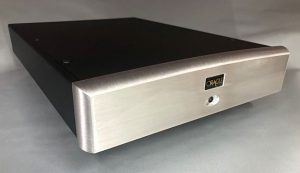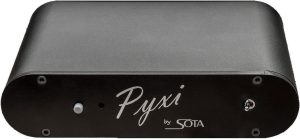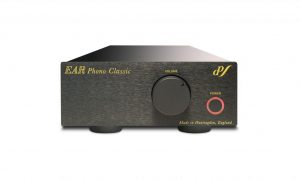Boulder electronics, out of Louisville, Colorado, has been diligently creating some of the finest audio components in the world since 1983. Founded by Jeff Nelson, Boulder's vision has largely been aimed at the state of the art, and those with deep pockets. For instance, the 3050 monoblock amplifiers will rip $245,000 from your accountants bare white-knuckled fist. The new reference phono stage, the 2108, will snatch $52K off the top of your mountain of cash.
In recent years Boulder allowed some of their vast know-how to trickle down, resulting in the their most accessible line, the 800 series. This range included the 865 integrated amplifier at $12,500, the 810 preamplifier at $7500, the 850 monoblock power amplifier at $11,500/pair, and the 860 stereo power amplifier at $9000. These price points should make other manufacturers sweat bullets and raise their game as far as build quality and sonics offered by the Boulder line up.
With the subject of this review, the 508 phono stage, Boulder has decimated the price floor that even five years ago would have been pure kryptonite to the ideology of the cost-no-object approach that Boulder had built its legacy upon. At $5K, the 508 will be the bee in the bonnet of dozens of similarly priced phono stages from all walks of the audio manufacturing world. Anything even close to that price, even double the price, would do well to take notice. From what I have heard within my time with the 508, this phono stage makes absolutely no sonic excuses, and offers no apologies for build quality despite the modest, accessible cost.
The 508 is a left hook to the body followed by right upper cut to the chin for those that think they can waltz around the ring underestimating the diminutive stature, price, and streamlined simplicity of the 508. The 508 is about the size of a small pie, if that pie was made out of aluminum carved from a solid block. Alternating small radius/large radius corners with a smooth subtle bevel carved along its top edge gives the 508 a nice bit of personality. An on/off switch and mute button fill in the two shallow channels carved into the unfussy front panel. Balanced inputs and outputs, AC plug, fuse cap, and MM/MC selector switch fills the back panel. Input impedance is 100 ohms for MC (70dB of gain), 47k Ohms MM (45dB of gain), and 100 ohms at output. RIAA is the fixed standard curve.
Armed with the Ortofon MC Windfeld Ti cartridge on the pointy end of the outstanding VPI Avenger Reference TT, and the MIT Oracle EVO phono cable, I was in great shape to get the best out of the 508. The rest of the system includes the D'Agostino Momentum preamp, MIT Oracle EVO SHO balanced IC's, Pass Labs XA200.5 monoblocks, MIT AC169 speaker interface, and both the Lansche 4.1 and the massive Sunny Cable HW15 horn hybrid speakers. MIT Z Power Reference power chords were used throughout.
The 508 takes no time at all to demonstrate its strengths, showing little, if any, ambiguity. There is a clarity to the sound that illuminates all dimensions within any given recording. There seems to be nowhere for information to hide. No shadowy corners, no dim colorations altering timbre or limiting dynamics. At the very least, these qualities are balanced so well that finding limitations that may be revealed by reference grade phono stages very difficult to detect without a direct comparison. This balance frees the listener to explore a recording at will. Listening to Stanley Clark's If This Bass Could Only Talk, track after track sprang to life with incredible dimension, image separation, detail, space, and dynamics. The low bass lines are hair trigger quick with ultra clean transients and outstanding pitch definition.
French Manufacturer Devialet pressed a limited run of previously unreleased recordings, including a performance by Sarah Vaughn. The care of the pressing/mastering is immediately evident by way of the dead silent, silky vinyl. It's not surface noise in the traditional sense that's missing, there is a vanishingly low level of the medium itself getting in the way. It's kind of like outstanding digital in a way, but better. Sarah's voice is out front, staggeringly beautiful, and as full of humanity as Sarah truly was. Just tremendous is her instrument. Phrasing, dynamics, tone, texture all revealed with the backing band taking a back seat, set back on the stage. The 508 did nothing to interfere with, or add to the recordings unique and rare qualities.
With the big Sunny H3W15 in the system, 15 refers to the 15 inch woofer operating to 500 cycles crossing over to the ceramic horn operating to 11,000 kHz and the super tweeter taking over to 30K kHz, the sound passed on by the 508 was staggering. Theses speakers, like the 508, leave no stone unturned. The effortless dynamics and wide open space between, and around images, presented in lifelike scale, makes for some very engaging sound. Throw on some metal and hold on my friend. Disturbed The Infection is a go-to for what it does really well, and for what it can expose as weaknesses in the system. At its best, the pounding bass drum and guitar sync up with jack hammer power. The guitars sear and wail. David Draiman's vocals, the best in the business, growl ferociously yet manage to sound quite melodic. The heart of the midband and treble comes across as pure and unadulterated. No colorations, no deviations that revealed themselves over time. Just clean, clear, and spot on. Through lesser gear, the components can easily become overwhelmed and smear, compress, and congeal the mayhem presented by metal and complex jazz. The 508 fit in perfectly among what are unquestionably reference grade components. The sound remained perfectly composed, uncompressed, or edgy. Imaging remained stable and precise even at the peak insanity. There simply was no weak link in the chain. This is not the system the 508 would typically be considered for, at least that would be conventional wisdom. After all, the speaker interface alone costs 10 times as much as the 508. Though the dearly departed $28K D'Agostino Momentum phono stage set the bar, and in many respects, the 508 punched way above its weight. The Momentum phono does offer a bit more harmonic richness and a bit more timbral color, but I have to tell you, if you have not lived with the Momentum, you'd be hard pressed to feel short changed with the 508.
A more suitable comparison would be the recently reviewed Gryphon Sonnet. The $7500 Sonnet shares many of the fine qualities of the 508, yet diverges at a certain point. Both are very revealing, offering great insight into the recording. Both offer outstanding dynamics, and are just flat out fun to listen to. But Gryphon is as Gryphon does, same could be said for Boulder. The Gryphon presents a more bottom up balance. Bass and midbass presents with more weight and density, where the Boulder favors speed and openness down below. Overall, the Boulder is a shade lighter in tone. Not to be confused with brightness in the negative sense, just more brightly lit. The Gryphon leans more towards the D'Agostino, with a slightly darker, warmer character. I found neither right nor wrong, just a difference of flavor. The Gryphon only offers single ended in and out, but has greater loading adjustability via dip switches on the back panel. It also looks pretty outrageous but costs 30% more than the 508.
I've never lived with a Boulder component, let alone the least expensive product they offer. I really had prepared for a slight letdown commensurate with its modest price. Perhaps that's why I'm as delighted with it as I am. The Boulder 508 is the surprise that simply was not spotted coming. The 508 must be considered a huge achievement for a company that was built upon the cost-no-object mindset. I understand $5K may make it hard for many audio snobs to take it seriously in the context of a very high end system—and that would be a mistake. Whether you build a world class system around the 508 through a series of upgrades, or you let go of preconceived notions and give the 508 a try in your current mega system, you may be surprised as well as tens of thousands of dollars richer. I'm not suggesting there is nothing better, that would be foolish. What I am saying is you may find the 508 so competent and well balanced that you simply won't desire much more. That's where I find myself after my time with the 508. I really don't feel the need for more. As far as high end audio is concerned, how refreshing is that?
508 Phono Stage
Retail: $5000
Boulder









































